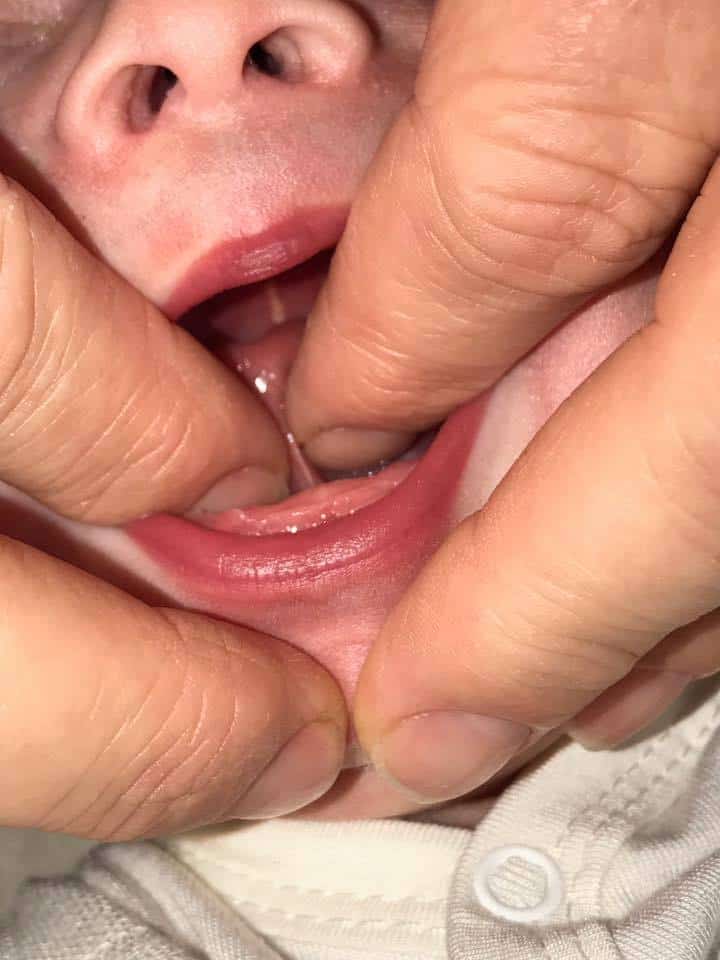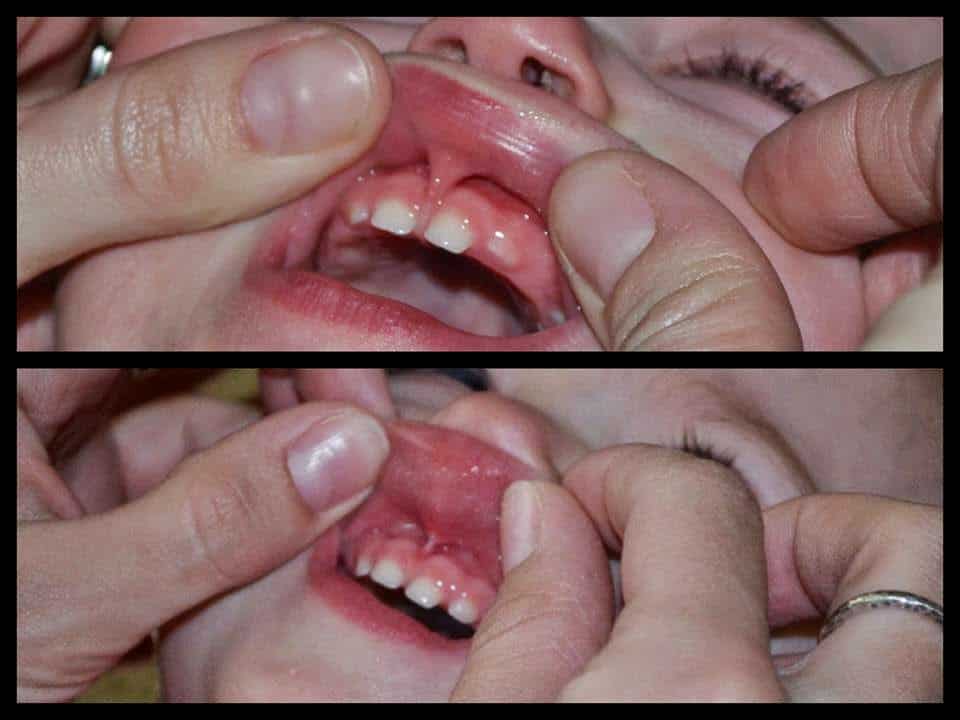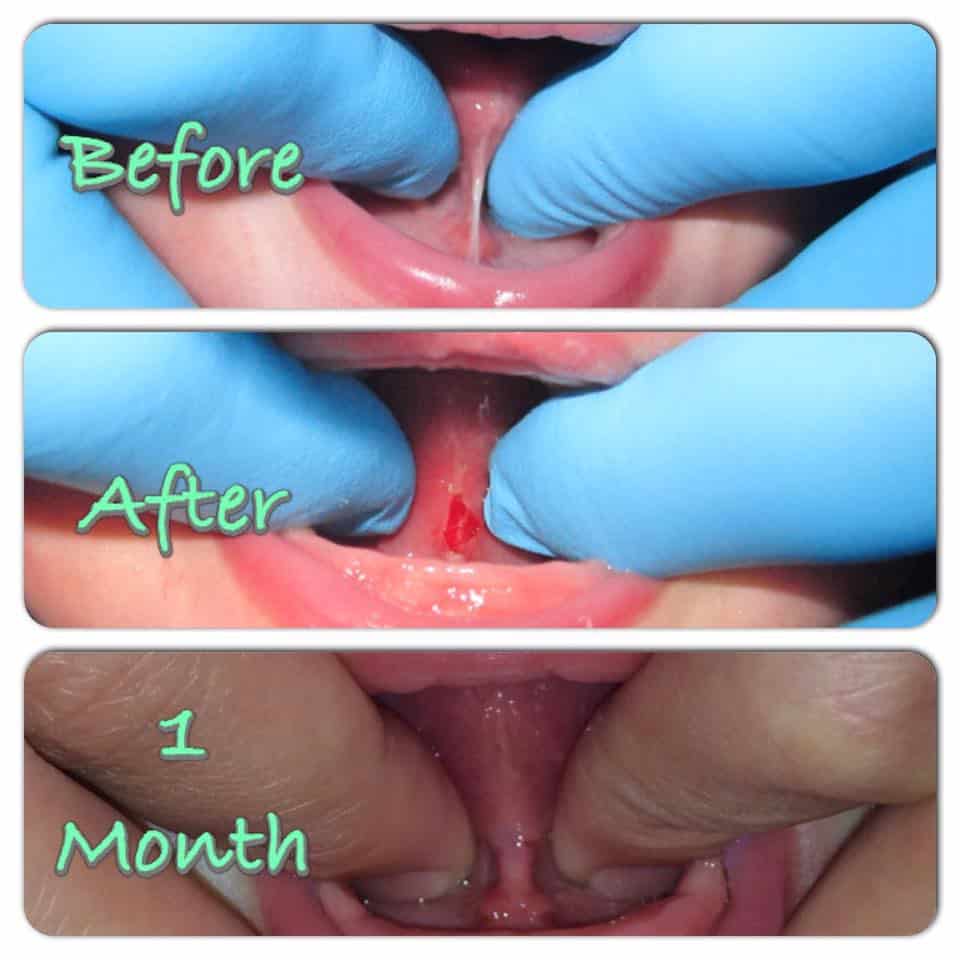Have you ever heard of a tongue tie? I’m not talking about when you get all confused end up sounding like a total asshole. I mean the physical connection between your tongue and the bottom of your mouth.
It was something I had heard of but never given much thought, until my son was born with one and I needed a crash course in how to deal.
So, what is it and why should you care?
What is a tongue tie?
Tongue tie, also known as Akyloglossia, is a common congenital oral anomaly affecting the movement of the tongue. When the tongue is tied, the frenulum that connects the tongue to the floor of the mouth is unusually short and thick.
The frenul-whatnow?
The frenulum is a thin band of tissue that restricts motion.
The one under your tongue forms in utero to guide the forward growth of the tongue.
There is a similar band of tissue between your top gums and the inside of your upper lip.
Your genitals also have a frenulum but we’re not going to cover that here today and I definitely don’t recommend Googling such things while you’re at work.
Go wash your hands and take a second to feel around in your mouth to see what I’m talking about.
As the mouth continues to develop, the frenulum will retract away from the front of the tongue. When that retraction fails to happen, or the tissue remains tight, you get a tongue tie.
Classification of tongue ties
The type of tie depends on where the frenulum connects to the tongue.
Classical (anterior) lingual frenulum:

This is the most commonly noticed tongue tie, as the connecting membrane extends towards the front of the tongue and is easily visible when the tongue is lifted. Often, when an infant with an anterior tie sticks out her tongue it has a heart-like or forked appearance.
Posterior lingual frenulum:

These ties are often missed, as the membrane connection is submucosal and therefore difficult to spot. In posterior ties, the frenulum is farther back on the tongue but still very tight. The front and sides of the tongue can move freely, but the center is anchored and unable to adequately lift or move forward. Sometimes these ties have to be felt for.
Lip tie:

The tongue tie’s upstairs neighbor, the lip tie, occurs when the frenulum between gum and upper lip is tethered too tightly. This has less to do with frenulum placement but rather the tightness. Even if the frenulum is tethered to the gumline, if the lips have adequate movement, it is not an issue.
Why does it matter?
In infancy, tongue and lip ties are potential causes of breastfeeding issues, such as:
- Shallow latch
- Prone to falling off the breast
- “Clicking noises” indicating loss of suction and intake of air
- Nipple and breast pain (including plugged ducts and the dreaded Mastitis)
- Low weight gain
Even if you are not breastfeeding, tongue and lip ties have been linked to problems throughout life, including:
- Speech problems
- Tooth decay
- Swallowing difficulty
- Orthodontic issues
- Inability to lick lips
- Difficulties kissing
Diagnosis
Some ties are noticeable at birth and many OBGYNs and midwives will clip them in the delivery room.
Here is a great step-by-step guide to checking for tongue and lip ties at home.
Older infants will need to be looked at by a provider well versed in tongue and lip ties. This could be a pediatrician, pediatric dentist, midwife, OBGYN, or International Board Certified Lactation Consultant (IBCLC). Not all providers are equally skilled at diagnosing ties. Ask around and find someone who comes highly recommended.

Controversy
You know there’s always a controversy about anything relating to babies. Practitioners have varying opinions on the existence and treatment of ties. Some do not believe posterior ties exist or that lip ties can interfere with breastfeeding. Others acknowledge the ties themselves but argue with the stated complications they can cause. There are also different methods for treatment, specifically relating to how much tissue to cut when releasing the tie.
Here is one alternative viewpoint, to help you make an informed decision.
Various providers in the hospital setting dismissed my concern about a tongue tie because he could stick his tongue out of his mouth, despite the obvious forked appearance when crying. When I finally saw an IBCLC she immediately suspected a tongue and lip tie and referred us to an ENT who clipped it. The improvement in our breastfeeding relationship from that point was immediate and steady. More than two years later we are still successfully breastfeeding.
So, should I seek out a specialist?
During my search for information, I was continuously referred to the website of Dr. Bobby Ghaheri in Portland, Oregon. Much of his practice is dedicated to educating parents about tongue ties, both in person and via his website. I reached out and asked him if the type of provider matters.
“This is the hard part. We’d like to think that oral surgeons or ENTs or pediatric dentists are “specialized” and that it somehow makes them good at everything in the mouth. That’s very wrong. The issue is going to any ENT or any oral surgeon or any pediatric dentist – it’s finding the doctor in your locale who is familiar with ties. In some communities, that’s a pediatrician who knows how to do a full release. Or a NP or a PA etc. It’s more about the provider’s individual skills rather than a broad category of provider that’s important.”
For more information, see his list of helpful questions to ask potential providers.
Educate yourself
I also asked Dr. Ghaheri to tell me the number one thing he wished parents knew about tongue ties.
“The #1 thing I want parents to know is that it is quite possible that they will end up knowing more about tongue tie than their providers, whether it be pediatrician, family doctor, lactation consultant, dentist or ENT. The research on the impact of tongue tie on breastfeeding is relatively new and hasn’t entered most training programs. Most doctors don’t take the time to learn about it, so the support system (if you can call it that) is cobbled together by some people “in the know”. Basically, my advice is to keep looking for support until you get your questions answered, which may require seeing several people. Our definitions of tongue tie are changing based on new research, but doctors haven’t caught up yet.”
Treatment
The procedure to treat a tongue tie is called a frenuloplasty. The provider will use medical scissors, a scalpel, or a laser to sever the connective tissue and release the tie.
It only takes a few seconds and many babies cry more from being restrained than they do about the frenuloplasty itself.
After the procedure
- There will likely be some blood — remember that when mixed with saliva, blood looks far more copious than it is.
- You can generally try to breastfeed immediately.
- Your baby’s mouth may be sore for a day or so. You can treat this with whatever over the counter painkiller your provider suggests.
- To prevent to two sides of the open wound from reattaching, you will need to do frenulum stretching exercises many times a day for the first few days. This generally involves lifting the tongue or upper lip to keep the wounds separate. Your provider will give you exact instructions and you can find videos of the process online.
- You may find immediate improvement of breastfeeding difficulties or you may need to work with a lactation consultant to help you train your baby how to use her newly mobile tongue correctly.


Takeaways
- Tongue ties are a common genetic anomaly in newborns that may persist into adulthood if not addressed.
- Ties are suspected causes of issues with breastfeeding, speech, and tooth decay, as well as self-confidence issues later in life.
- There are several types of ties and not all providers are equally experienced with diagnosis and treating them.
- Depending on the type of tie and the age of the baby, your provider may do the procedure in-office or refer you to someone who can.
Sally sells seashells by the seashore is a tongue twister that may leave you tongue tied but Akyloglossia is no joke. If you have a story to share, leave it in the comments!
Resources
- Dr. Bobby Ghaheri’s website, blog, and Facebook page are an overflowing cornucopia of all things tie related
- Pediatric dentist, Dr. Lawrence Kotlow has an array of handouts and information regarding tongue ties
- A video of one method of post-revision care and exercises
- Special thanks to Dr. Ghaheri and everyone who shared photos and stories of their experiences over on the Pregnant Chicken Facebook page!




Leave a Comment